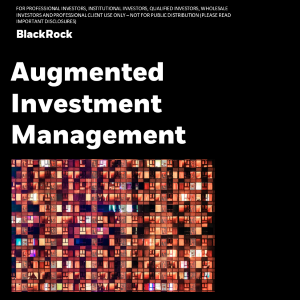Skip to content
Welcome to the BlackRock site for institutional investors
Before you proceed, please take a moment to review and accept the following Terms and Conditions:
BY CLICKING ON “I AGREE”, I DECLARE I AM A WHOLESALE CLIENT AS DEFINED IN THE CORPORATIONS ACT 2001.
What is a Wholesale Client?
A person or entity is a “wholesale client” if they satisfy the requirements of section 761G of the Corporations Act.
This commonly includes a person or entity:
- who holds an Australian Financial Services License
- who has or controls at least $10 million (and may include funds held by an associate or under a trust that the person manages)
- that is a body regulated by APRA other than a trustee of:
(i) a superannuation fund;
(ii) an approved deposit fund;
(iii) a pooled superannuation trust; or
(iv) a public sector superannuation scheme.
within the meaning of the Superannuation Industry (Supervision) Act 1993 - that is a body registered under the Financial Corporations Act 1974.
- that is a trustee of:
(i) a superannuation fund; or
(ii) an approved deposit fund; or
(iii) a pooled superannuation trust; or
(iv) a public sector superannuation scheme
within the meaning of the Superannuation Industry (Supervision) Act 1993 and the fund, trust or scheme has net assets of at least $10 million. - that is a listed entity or a related body corporate of a listed entity
- that is an exempt public authority
- that is a body corporate, or an unincorporated body, that:
(i) carries on a business of investment in financial products, interests in land or other investments; and
(ii) for those purposes, invests funds received (directly or indirectly) following an offer or invitation to the public, within the meaning of section 82 of the Corporations Act 2001, the terms of which provided for the funds subscribed to be invested for those purposes. - that is a foreign entity which, if established or incorporated in Australia, would be covered by one of the preceding paragraphs.

INVESTMENT ACTIONS
Augmented Investment Management
In our data-rich world, active managers are tasked with distilling several sources of information into a holistic view. Learn how we are bringing together human expertise and AI technology to enhance active management capabilities.
Key points
-
01
Expansion of investment signals
Active managers today may codify the growing volume of predictive investment signals into actionable insights to build quantitative alpha models in portfolios.
-
02
Machine learning for alpha forecasts
Machine learning can provide a dynamic alternative to discretionary alpha model design. In 2014, BlackRock Systematic created Augmented Investment Management (AIM) to train models that generate alpha forecasts from vast signals.
-
03
Designing systematic alpha models
Using a combination of machine learning and human expertise, portfolio managers can design regime-aware models to capture opportunities as they arise.
Our approach: Transforming information into alpha signals
Successful active management, in our view, relies on the premise that investors can gain an informational advantage over other market participants to generate excess returns. Systematic investors codify information sources into predictive investment signals that serve as building blocks in an investment strategy. For example, we can apply text analysis algorithms to analysts reports to gain insight into whether analysts have a positive or negative view.
In an increasingly data-rich world, there are now potentially hundreds or even thousands of signals available to investors. This raises a new challenge for systematic investors, which is how to optimally combine investment signals.
Advances in machine learning offer powerful tools to help address the challenges faced by investment managers in designing alpha models. Starting in 2014, we set out to design a system that can train machine learning models for alpha forecasts. We named the system Augmented Investment Management (“AIM”). AIM is a system for building systematic alpha models from a large collection of signals.
Our framework: modular machine learning for portfolio managers
AIM relies on two key ingredients. The first is a comprehensive signal library with substantial historical data available for model training. The library includes a wide range of signals from different sources, such as financial statements, market indicators, news and analyst reports, and an array of alternative data sources. Figure 1 illustrates the growth in the number of stock-selection signals developed by our team over the past 40 years.
The second ingredient is a high-fidelity, high-performance portfolio optimizer and performance simulator. The portfolio optimizer is used to transform forecasts into portfolio positions by solving a constrained optimization problem accounting for portfolio risk. The performance simulator then evaluates portfolio holdings over a historical backtest period, and model parameters are adjusted with the goal of maximizing a specific performance metric. The simulator accounts for transaction costs, borrow costs, and fund constraints to produce evaluation results that approximate realized portfolio performance with high fidelity.
At its core, AIM is designed as a modular machine learning pipeline that can be configured and customized by portfolio managers. AIM allows managers to create models that are sophisticated enough to capture complex signal interactions yet general enough to seek to perform well on unseen data, balancing model capacity with versatility.
Customizing alpha models
A key benefit of machine learning systems is the low marginal cost of designing custom alpha models. Thus, portfolio managers can use AIM to design regime-aware models that are trained to be more resilient during negative regimes.
A simple and intuitive approach to training resilient models is to overstate the likelihood of negative regimes in the historical data used to train the model. This is akin to training the model on an alternate history where the prevalence of negative states is significantly higher. As a result, the model learns to find investment patterns that perform well during negative regimes.
These methods are also used to help safeguard against the pitfall of over-reliance on a dominant market regime in the training data. Through a training regime that emphasizes a higher frequency of negative states, the model explores diverse investment patterns for robust performance across market variations. This technique insulates AIM models against over-fitting to a particular market regime.
Ongoing research directions
Signals can lose efficacy over time as a source of data becomes commoditized or underlying mechanisms become widely understood by market participants. BlackRock’s Systematic investment team has been working to continuously improve AIM by researching new approaches to address this challenge. One research direction the team is exploring focuses on developing adaptive learning algorithms. These algorithms attempt to identify and adjust to changes in the distribution of financial data over time. Another promising research direction involves the incorporation of domain-specific knowledge and economic indicators into the model to better capture the underlying dynamics of financial markets. By incorporating information related to market cycles, macroeconomic factors, and other relevant data, the model may be better equipped to adapt to changes in the relationships between different signals.
As the proliferation of new data results in the multiplication of innovative new investment signals, AIM seeks to help systematic investors automate ans better optimize the process of signal combination. The calibration and refinement of alpha models by expert portfolio managers brings this system to life - enabling models to be designed and optimized for navigating a wide range of investment objectives and market conditions.
Read the full report
Learn how we are bringing together human expertise and AI technology.




